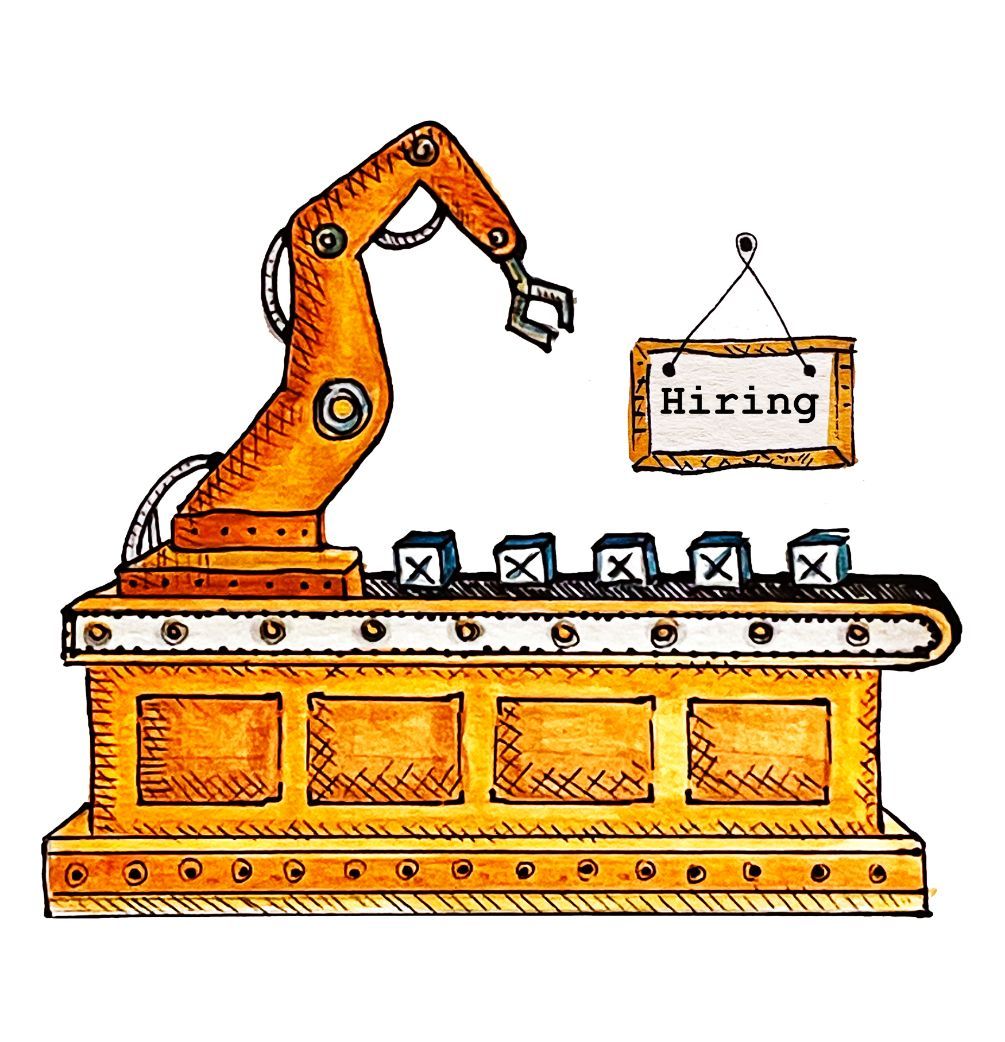'Culture' is more than a buzzword in business + how it helps businesses and workers get what they want
Turns out, workplace culture is crucial to recruitment. Job seekers can bring their needs and values to the table.
Turns out, workplace culture is crucial to recruitment. Job seekers can bring their needs and values to the table.

Culture in the workplace – it's kind of a big deal
The labor market is so tight that one business I contacted for an interview about worker recruitment asked me to make an employment referral in exchange for the interview.
I said no. It's not ethical for me to make trades like that with sources. But it struck me. Employers are approaching recruitment and retention in unconventional ways.
I started this story looking for solutions to the worker shortage challenge. (Remember: Solutions journalism is rigorous, evidence-based reporting on responses to problems.) Robots and other technologies are helping companies manage staff shortages.
And I found a few successful businesses whose leaders say good culture is paramount. One expert I spoke to called culture a differentiator. Another called it "the most important factor" in employee retention.
What even is workplace culture? Read on for some fascinating insights.

Good corporate culture is a priority for businesses in today's labor market. (Andi Arnold for The Optimist)
How culture helped 2 St. Cloud manufacturers grow despite the tight labor market
By Nora Hertel for The Optimist
ST. CLOUD – It’s a job-seekers’ market now.
Central Minnesota employers are getting creative to meet the needs they see in their coveted workforce. Some are helping open child care centers so working parents have a safe place for their kids. Some are recruiting Twin Cities residents to commute north. There are sign-on bonuses and referral bonuses.
“And then it’s just the culture in the building. Is it friendly? Is it welcoming?” said Gail Cruikshank, talent director with the Greater St. Cloud Development Corporation.
A business's culture is essentially its personality, said Martin Breaker, chair of the Department of Management and Entrepreneurship at St. Cloud State University. It bears out in written and unwritten rules, in procedures, in professed and performed values.
"In my opinion, culture is the most important factor in retaining employees," Breaker said. "The literature says that 46% of employees view culture as the number one thing. I think it's actually more than that."
So what does a good, intentional culture look like? Experts agree it's responsive to employees and treats them with respect. Good culture is important for attracting young workers, and it's likely to remain important as the demand for workers is expected to stay high.
Unemployment was at a record-low 1.8% in June in Minnesota and at 3.6% for the U.S. as a whole.
There's a lot of variety in organizational culture. It's not simply good or bad. Although there are plenty of examples of problematic culture in corporate history. The Enron Corporation collapsed amid fraudulent practices and a culture of aggressive trading and intense internal competition.
Some companies can successfully emphasize results. Results, authority, safety and order are four of eight culture and leaderships styles in a model published by Harvard Business Review in 2018. Other styles that focus more on flexibility are caring, purpose, learning and enjoyment.
"Whoever founded the business will set what is acceptable and not acceptable. Now, that can change over time," Breaker said. "Normally it's the top person that really sets the agenda for the culture of the business."
A case study
St. Cloud employer Park Industries makes a particular effort to incorporate good values and culture into recruitment efforts, marketing and everyday interactions.
“I’ve often said if we get the right person who fits our culture, we can train them,” said Park Industries' Director of Marketing Stephanie Kadlec. “That is a big focus for us. We have cultural interviews just centered around asking the trust, integrity and respect questions. It’s that important to us.”
The ParkWay, as they call it, was established in 2001 and lifts up those three values: trust, integrity and respect. In 2020, Park Industries won the Manufacturer of the Year award from the Manufacturers Alliance of Minnesota. Park manufactures stone working and metal fabrication equipment.
"I know we're better, because I've been in other cultures," Kadlec said. "We do have something unique."
Park's turnover rate for last year was 9.17%, according to Kadlec. That's compared to 39.9%, the Bureau of Labor Statistics' average turnover in manufacturing last year.

Manufacturers feel the crunch of a worker shortage. (Andi Arnold for The Optimist)
'A great work environment'
Turnover rate is a good way to measure culture, said Bob Kill, president and CEO of Enterprise Minnesota, a consulting organization that serves manufacturers. If turnover is 50%, something is wrong.
More and more manufacturing companies are working to improve their environments and their culture, because those things matter to young workers, Kill said.
Improvements could involve changes to the physical space, like new air conditioning. Improvements could involve added flexibility for work shifts – such as four-day or three-and-a-half-day work weeks – something previously unheard of. And they often involve investing in people directly, in their training, safety and career advancement.
"Many want to be known as having a great work environment. And I've seen it," Kill said. Those changes were coming slowly and have accelerated as workers have more options.
A good cultural fit is not the only factor at play. Pay and benefits matter. Work-life balance matters for many. And people from different generations have different priorities.
"Younger employees, more educated employees nowadays prefer a more flexible structure, more supportive, maybe less competition, maybe less bureaucracy and more creativity," said Mana Komai Molle, St. Cloud State University's Economics Department chair.
Promotion from The Optimist
Sign up for the newsletter!
Did someone forward you this newsletter? Did you happen upon it online? Don't miss future issues. In coming weeks we'll feature Minnesota artists, solutions in higher education and a series on preventing veteran suicides.
Join The Optimist's mailing list!
Another case study
Central McGowan, a 75-year-old company that provides equipment and gases for welders, restaurants and manufacturers, launched a culture committee in late 2021. The committee will give feedback on benefits and safety among other duties, said President and CEO Joe Francis.
Central McGowan has some flexible scheduling and most driving positions come with four-day work weeks, Francis said. That's on top of tangible things like competitive pay and benefits and intangibles, like caring about employees and wanting them to spend their entire careers there.
"You may not always like the job, but as long as you like the place you come to work to and the people you surround yourself with, you'll stick with it," he said.
His employee count has more than doubled in the last 10 years, as Central McGowan has bought and brought in other companies and their staff. Overall growth in manufacturing is due to economic growth, reshoring work to the U.S. and a desire for local products, Francis said.
“Culture is an abstraction, yet the forces that are created in social and organizational situations that derive from culture are powerful.” – Edgar Schein, Organizational Culture and Leadership
Promotion from The Optimist
Get some swag featuring The Optimist's fab logo!
Grab a sticker, T-shirt, magnet, notebook and more to support The Optimist! All profits help fund solutions journalism and local art.

Add in a few robots
Central McGowan is also busy helping other companies automate parts of their processes. Yes, that means robots and other technology to take on repetitive or dangerous parts of the work so valuable staff can spend their time and brainpower elsewhere.
"There's very much a realization that automation is going to be essential to the onward expansion of our economy," said Susan Goldstein, associate professor in the Carlson School of Management at the University of Minnesota. A well-trained and educated workforce is part of that equation too.
Goldstein is an expert in supply chain and operations. Supply chains are focused on quality and an organization's culture is key to those efforts. Workers need to feel that management wants to hear from them and that they won't be penalized for highlighting problems, Goldstein said. "The effects of culture can be very tangible."
Employee surveys are a common tool to facilitate feedback. Most good organizations do this to keep "a finger on the pulse," Goldstein said.
Central McGowan and Park Industries survey and check in with employees regularly.
Park Industries’ Vice President of Manufacturing Duane Bryngelson said he tries to address real-time feedback.
He walks the floor every morning to check in with employees on how they feel about their workload and ask if they have everything they need, Bryngelson said. “I ask a lot of them: If we had to run at this pace, are we running at a sprinters pace trying to run a marathon? Or is this sustainable? And if not, what would it take?"
Promotion from The Optimist

Advertise with The Optimist! We can grow together!
We're now soliciting trades for ad space. Share our content with your network and get an ad spot here! Contact Nora: nora@theoptimist.mn
Visit the store front (it's a work in progress!)
Find a culture for you
Experts agree that employees can see through BS. If an organization doesn't follow its professed values or seem sincere in its support of workers, workers will know.
"Corporations can spew a bunch of values. All of them are basically the same," said Komai Molle, SCSU's Economics Department chair. Job candidates want to see how those principles are applied.
And with today's culture of online sharing, workers can research employers to see if they walk the walk.
Komai Molle recommends job seekers recognize what they want: How much pressure can they handle? How much flexibility do they need? Then pay attention to who's on the hiring committee, what employees say in surveys and use personal judgement to help the assessment.
"Corporations have a hard time hiding who they are," Komai Molle said.
Story behind the story
This story started with the challenge of high unemployment. On Monday there were nearly 7,500 jobs posted on the Greater St. Cloud Job Spot board, which covers three counties around St. Cloud.
I first sat down in February with Gail Cruikshank at the Greater St. Cloud Development Corporation, and she shared what she has seen growing businesses do to take on that challenge. How do they attract and keep associates? She introduced me to a few of those businesses. I talked with leadership and with a new employee at Park Industries who didn't make it into the final story. And I connected with four business experts for different angles on the issue:
- Martin Breaker, SCSU Management and Entrepreneurship Department Chair
- Susan Goldstein, Associate Professor of Supply Chain and Operations at the University of Minnesota
- Bob Kill, President and CEO of Enterprise Minnesota
- Mana Komai Molle, SCSU Economics Department Chair.
I also read a number of papers on work culture and parts of Edgar Schein's book Organizational Culture and Leadership.
As a new entrepreneur myself, I found it all fascinating. I now plan to be very intentional about the culture at The Optimist!
The illustrations were fun to commission. Artist Andi Arnold drew a robotic arm in a short-staffed facility to capture the problem. And she pulled together a diverse group of workers for our culture/solution image we affectionately called "Go Team Go!"
Thanks for reading!
♥ Nora
What did you think? Tell us in a survey!
Our mailing address:
P.O. Box 298
St. Michael, Minnesota 55376
Copyright © 2022 The Optimist, All rights reserved.

